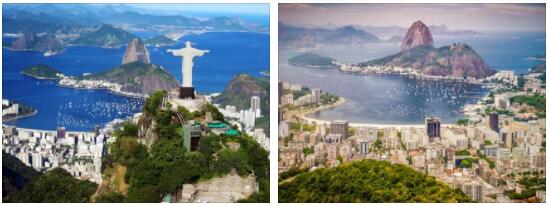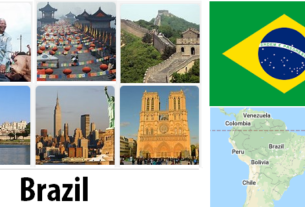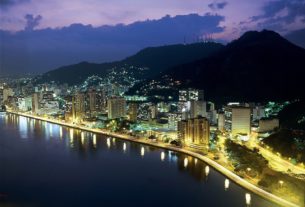According to programingplease, Rio de Janeiro is the main tourist attraction in Brazil. The city is truly amazing. Endless beaches coexist here with modern city blocks, monuments of colonial architecture stand next to skyscrapers, and the rainforest is located a short drive from the center.
The history of the city began in the 16th century. On January 1, 1502, the Portuguese Andre Gonsalves, who was commissioned by the king to explore the lands recently discovered by Cabral, noticed the bay. Mistaking it for the mouth of a large river, he gave it the name “Rio” (river). The Portuguese called the islands and continents they discovered by the name of the saint who patronized the corresponding day. The first of January did not have its own saint, and they supplemented “Rio” with the definition of “de Janeiro” (January). The name of the place turned out – Rio de Janeiro – January river. On March 1, 1565, the city of Rio de Janeiro was founded by General Estacio de Sá at the site of today’s Botafogu . After 50 years, the population numbered 3,000 Indians, 1,000 whites and a hundred slaves employed in logging and sugar cane plantations. In 1763, the city of Bahia – the then official center of Brazil – began to cede its dominant role to Rio de Janeiro, which turned out to be the main point connecting Minas Gerais (the main mines where gold and diamonds were mined) with the outside world. In 1808, after half of Portugal fell to Napoleon, the royal court moved to Brazil. And later, in 1816, Rio de Janeiro becomes the capital of the Portuguese Empire.
In 1872, Rio de Janeiro had 250 thousand inhabitants. Beginning in 1889 they were joined by ex-slaves from the northeast and immigrants from Europe, mostly Portuguese speakers. In 1900, Prefect Pereira Passus reshaped the city in the spirit of the French architect Haussmann. The limited space forced the 700,000 inhabitants to settle farther and farther from the center, and the buildings to grow upwards.
In 1959, the city lost the status of the capital, Brasilia became it . But Rio remains the country’s showcase: offices of many enterprises operate here, the first airport in Latin America is located here, and it is here that tourists come to see the “city of wonders” on the ocean.
The main attraction of the city is a thirty-meter Statue of Christ the Redeemer on top of Mount Corcovado. The height of the statue itself is 30 m, not counting the seven-meter pedestal. The idea for this structure was born in 1922, when the centenary of Brazil ‘s independence was being celebrated. A project competition was announced for the best monument – the symbol of the nation. The winner – Héctor da Silva Costa – put forward the idea of a statue of Christ, arms outstretched, embracing the whole city. A special tram goes to the top of Corcovado, its final stop is just 40 m below the statue. From it you need to climb 220 steps of stairs or take the elevator to the pedestal, on which the observation deck is located – the best place to get to know the city for the first time. You can also get to the top by car on the freeway passing through the Tijuca State Reserve.. Tijuca is the largest urban forest in the world. If you are not going to the Amazon, the reserve can give you some idea of what the jungle is like.
Pan do Assucar or Sugar Loaf is a natural symbol of Rio. This 395 m high stone rock is located at the entrance to Guanabara Bay. It is assumed that the mountain is named so because of its shape, which is very reminiscent of the conical outlines of the old packaging of “sugar loaves”. It is more likely, however, that the name comes from the Indian words “paunh-acuqua”. In the Tupi language, it simply means “high hill”.
The historical part of the city is located in the central part of the city. Here is the residence of the Portuguese rulers, called the Paco Imperial. After the fall of the monarchy, the palace was used as a warehouse, bank, post office, so only the facade has survived from the old building to our time. The city center is rich in interesting churches. On the site of the Cathedral of La Candelaria there was a temple, founded at the end of the 16th century. by a sailor who vowed to build a church if he survived the storm. And in 1775, Francisco Rocio proposed a modern project for the church, which was brought to life. In 1811, Prince Regent João VI opened the cathedral, however, not for long. It immediately began to be rearranged and the faithful were able to get inside again only in 1890. The parishioners were surprised and fascinated by the bronze doors cast in France, which were even presented at the World Exhibition in Paris in 1889. Inside the cathedral there are stained-glass windows, chapels, arches and paintings.
Another interesting monument is the Cathedral. This modern building, completed in 1976 after 12 years of construction, has an original architectural appearance. It looks like a reinforced concrete block entangled with scaffolding. The cathedral is visible from many places in the city center, from the Corcovado and Sugar Loaf mountains, from where it seems that this eighty-meter building is the main building in the city. The Museum of Religious Art is located in the underground room of the church. The outstanding architectural monuments of the city are the colonial churches of the Glory of the Virgin, the Glory of the Virgin on the Hill and many others, the monasteries of San Bento, San Antonio and the Capuchin Order. The famous Bondinho Tram departs from the centrally located station, passing on its way along the Arces di Lapa aqueduct, built in 1732. The southern region is famous for its beaches. Among them – Copacabana, Ipanema, Leblon. The total length of city beaches is about 90 km. Copacabana beach has become a symbol of Rio de Janeiro. It is not only one of the most famous beaches in the world, but also one of the widest – in some places its width reaches 100 m. The length of Copacabana is 4 km. The sand on the beach is light yellow and coarse. Most tourists try to stay here, in one of the hotels on Atlantic Avenue. This place is crowded on weekends. Ipanema borders Copacabana on the west, and Leblon continues with Ipanema. These two beaches are located in the same bay, sandwiched between Cape Arpoador and the mountain of the Two Brothers. They are similar to Copacabana, but there are fewer people and more waves, so they are preferred by surfers. In addition to these three popular places, you can also visit the beaches of Urca, Vidigal, Pepino San Conrado, Barra de Tijuca, Recreu dos Bandeirantes, Grumari. The city beaches of Flamengo and Botafogo are rarely visited due to mud.
In the north of Rio de Janeiro is the Maracana Stadium, which is one of the largest stadiums in the world. It can accommodate 120,000 people. In addition to the stadium, the landmark of the northern region is the old royal palace, which now houses the National Museum.
Rio is the cultural and scientific center of the country, only in the National Library there are 2 million items of storage, and among them are the rarest books and manuscripts. The National Museum of Fine Arts has collected more than 800 paintings and drawings. The expositions of the Museum of Modern Art, the National Historical Museum, the Museum of the Republic, the Museum of Jewels are very interesting.
The streets and embankments of the city are literally buried in lush equatorial vegetation – evergreen giant trees, slender palm trees with graceful crowns, a huge number of exotic flowers. Nevertheless, the city has a Botanical Garden and many parks. In the botanical garden, founded in 1808 and one of the best in the world, has collected more than 7,000 plant species from all over the world. Here is also the famous avenue of palm trees and a collection of exotic animals and birds.
Of course, most of Rio de Janeiro is known for its annual grandiose carnival, which glorified not only the city, but the whole of Brazil. The first carnival was held in the 19th century. As in those days, today the holiday begins before Lent and lasts 5 days. The highlight of the carnival is the parade of samba schools, held at the specially designed so-called Sambadrome. Each school develops one topic: politics, nature, sports, art, music – all topics must be Brazilian. Carnival in Rio de Janeiro – these are beautiful carts, many musicians, magnificent costumes, on which the last money is often spent, and fiery samba rhythms. And 100 thousand spectators watch this show from the stands along the path of the dancers’ procession.



